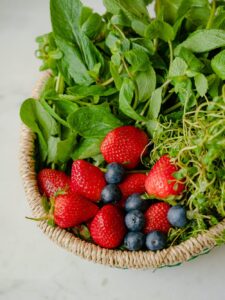May 2022
Why are Americans so Nutrient Deficient??
Spring! Purple crocus peeking through the thawing ground offering a brilliant burst of color, welcome by those happy they survived another winter here in Montana, yet perhaps unwelcome by those who prefer blue — as in a bluebird day — not ready to store their skis for the season. Spring brings our farmers’ markets alive with more and more fresh fruits and vegetables each week until bins are bursting with vine-ripened tomatoes, leafy greens for days, and amusingly-shaped carrots, culminating late-summer with a Treasure State treasure (and the reason to set an alarm clock on a Saturday) — Dixon melons!
Spring is also the time of year the Environmental Working Group (EWG) releases its infamous Clean 15 and Dirty Dozen lists. Every year, they analyze the most recent USDA data to compile the types of fruits and vegetables grown with the least and most pesticides. According to the USDA, more than 225 different pesticides — glyphosate being the most ubiquitous — can be found on fruits, vegetables, and grains. Why should we avoid glyphosate? It’s been well established that glyphosate is an endocrine disruptor and has been getting a lot of attention for its connection to cancer, but what many do not know is that the pesticide was first patented as a metal chelator (remover) that binds to minerals, like calcium, to clear them out of pipes. This could put you at risk for a mineral deficiency, already a concern due to the loss of minerals in our soil and water. Glyphosate can also kill beneficial gut bacteria, changing the gut microbiome and thus affecting the immune system (as 70-80% of our immune system resides in the gut.) And a recent study shows that pregnant women living near farms where pesticides are applied have a 60% increased risk of children having an autism spectrum disorder.
So while beneficial that the dangers of pesticides are becoming more widely known, the consequence, according to a study by the Illinois Institute of Technology, Chicago, is that after seeing pesticide messaging, low-income shoppers were less likely to purchase any fruits or vegetables. The message needs to be clear: eating fresh fruits and veggies should always be a part of our daily diet, even if that includes non-organic choices. Substituting organic strawberry fruit snacks, sadly, won’t cut it. Before your next trip to the grocery store (which, as of late, could include stopping at the pawnshop or cashing out some stocks), be sure you screenshot this list for reference on the cleanest non-organic choices and which produce will be worth the extra buck to go organic.

DIRTY DOZEN
1. Strawberries
2. Spinach
3. Kale, collard, and mustard greens
4. Nectarines
5. Apples
6. Grapes
7. Bell and hot peppers
8. Cherries
9. Peaches
10. Pears
11. Celery
12. Tomatoes
CLEAN 15
1. Avocados
2. Sweet corn
3. Pineapple
4. Onions
5. Papaya
6. Sweet peas (frozen)
7. Asparagus
8. Honeydew melon
9. Kiwi
10. Cabbage
11. Mushrooms
12. Cantaloupes
13. Mangoes
14. Watermelon
15. Sweet Potatoes
While we’re on the subject of eating the cleanest fruits and veggies, what about the most nutritious? Have you noticed your produce is losing its vitality and taste? Not to mention its nutrients. The food Americans eat today is 25-50% lower in nutrients than 50 years ago. In Alex Jack’s report, America’s Vanishing Nutrients, he discusses how the decline in the quality of fruits and vegetables poses serious health and environmental risks.
Half of the American population has at least one preventable chronic disease — which is often attributed to lifestyle choices. While those choices do play a big role in our health, we cannot ignore that America is nutrient deficient. And that’s not just because of the Standard American Diet (which is primarily chemical-filled processed junk food devoid of any nutrients); it’s because our healthy food like fruit and vegetables has seen drastic decreases in nutrient levels.
The following examples are per the USDA food composition tables comparing nutrient levels in vegetables from 1975 to 1997 and in fruits from 1975 to 2001. (The most recent data available.)
Calcium content is down:
• 50% in broccoli
• 58% in pineapples
• 65% in tangerines
Iron is down:
• 85% in grapefruit
• 78% in peaches
Vitamin A is down:
• 87% in grapefruit
• 68% in cauliflower
• 67% in strawberries

One analysis concluded that today we would need to eat eight oranges to get the same amount of vitamin A our grandparents would have gotten from one! Research shows that 45% of Americans are deficient in Vitamin A, which impacts our immune system. Of the twelve vegetables sampled, all 12 vegetables lost calcium, eleven of 12 lost vitamin C, ten of 12 lost iron, and eight of 12 lost vitamin A. Two vegetables recorded increases in selected nutrients, vitamin A and vitamin C in carrots, while cabbage increased in vitamin A and iron, likely the result of new hybrid seeds developed to boost these specific nutrients.
In addition to being vitamin deficient, Americans are also mineral deficient. Minerals are one of the most overlooked factors regarding nutrition and maintaining a healthy, disease-free body. Two-time Nobel laureate Dr. Linus Pauling said, “You could trace every disease and every ailment to a mineral deficiency.” Your body needs at least 60 different minerals to function properly. And did you know that your body can use minerals without vitamins, but vitamins and other nutrients are useless without minerals??
What is the primary cause of this decline in minerals and vitamins? Some would argue it’s the global environmental crisis, including increased air and water pollution, GMOs, rising soil infertility, and heavy use of chemical pesticides and fertilizers. Pesticide use increased by 222% between 1960 and 1981. Pesticides damage the organisms that live in soil, and good food cannot be grown in dead soil. Just as we need good bacteria in our gut to help digest food properly, plants need these beneficial bacteria and fungi to digest their food from the soil.
It’s no secret that our soils started losing these vital nutrients soon after small farmers got pushed out for larger industrial farms. The number of farms in the U.S. decreased by 64.5% between 1950 and 1997, and the average farm size more than doubled. With modern industrial farming from ‘Big Ag,’ there is a tradeoff between yield and nutrient content, so we are ‘food rich but nutrient-poor.’ Traditional farming rotates crops to avoid the depletion of minerals. For example, corn and wheat absorb different minerals from the soil. Yet, larger industrial farms produce a single crop year after year and instead rely on chemical fertilizers to make plants grow bigger and faster. Every year, the government spends billions to support commodity crops like corn, wheat, cotton, and soy. In fact, you may lose your appetite for any food after reading this: Between 1995 and 2019, fifty people on the Forbes 400 list of the wealthiest Americans received farm subsidies, while 62 percent of U.S. farms did not receive any subsidies. Oh, and by the way, in 2019, Big Ag spent a total of $143,344,380 lobbying members of Congress. Agricultural subsidies are enriching large agribusinesses, supporting degenerative farming practices, which diminishes soil health leading to less nutritious food.

Fortunately, there’s something we can do to help. Regenerative farming practices are on the rise, and there are many benefits, according to Regenerative Farmers of America:
• Reverses climate change: Emissions reduction alone is inadequate. Luckily, the science says that we can actually reverse climate change by increasing soil carbon stocks.
• Improves nutrition: Healthy soils produce more nutrient-dense foods with higher levels of certain vitamins, minerals, and phytochemicals. Phytochemicals are not conventionally considered nutrients however they are still relevant to chronic disease prevention.
• Creates drought-resistant soil: The addition of organic matter to the soil increases the water holding capacity of the soil.
• Revitalizes local economies: Family farming represents an opportunity to boost local economies.
Here are a few websites to help you support regenerative farmers:
Regenerative Farmers of America
Regeneration International
Kiss the Ground
Wild Pastures
Grass Roots Farmers’ Cooperative
Farmers Footprint
Other Shopping Tips:
• The cost of feeding our families is at an all-time high making low-cost, nutrient-deficient food not only tempting but for many, it’s the only option. If you haven’t already, reevaluate your grocery list or other spending habits to see what you can live without.
• Buy fruit/veggies in season and locally whenever possible. Ask the vendor/grower about pesticide use (some can’t afford the cost required to be labeled organic.)
• Avoid packaged foods and aim for mainly nutrient-dense, whole foods.
• Plan your meals for less waste. Find recipes that incorporate the same ingredients.
• Use the store’s app for digital coupons.
Remember, what you put into your body is either hurting you or helping you. Making the effort to eat the right food supports not only your health and the health of your family but supports local farmers, as well. Anything to keep those Dixon melons coming!
Krokus photo by Trey Musk, orange photo by Julie Aagaard, soil by Tim Mosshikder: pexels.com; tractor photo by Jeff Kenney, Montana

